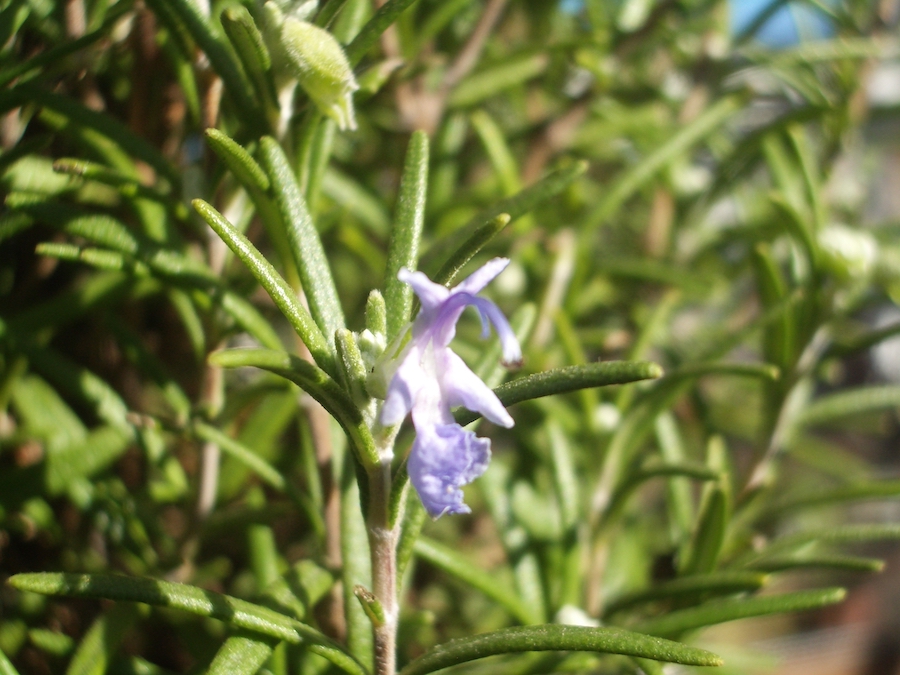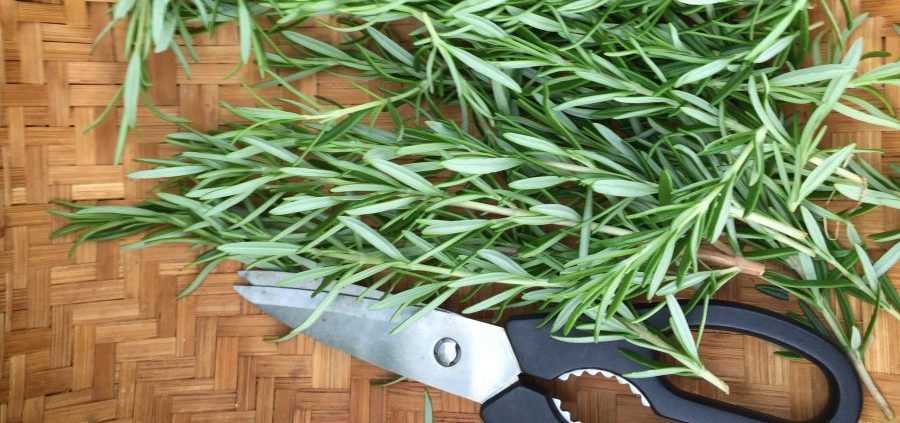Student Monograph ~
Rosemary
(Salvia rosmarinus, formerly Rosmarinus officinalis)
This Materia Medica assignment (new, more in-depth style) was written by Liz Kelly
with additional input from Maria Noel Groves (MNG) and Ruth Droescher (RD).
Family: Mint (Lamiaceae) (2,5,6,7)
Part(s) Used: leaf/needle/aerial parts (1,2,3)
Key Actions: carminative (1,2), antimicrobial (1,2), antioxidant (1,2), antispasmodic (1), rubefacient (1), aromatic (2), stimulating/nervine (2), hepatic (2), circulatory stimulant (1,2), nootropic (7)
Flavor: pungent (1,2), bitter (1) aromatic (7)
Energetics: warming (1,2), drying (2) moving/diffusive (7)
Identification/Growth:
“Rosmarinus” means “dew of the sea”, which automatically transports us to a place where rosemary grows densely near the Mediterranean Sea. Rosemary is a small, woody, evergreen shrub in its natural habitat (in the Mediterranean region) (2). It thrives in harsh conditions and rocky soils (2). Though in warmer climates this plant is a perennial, here in New Hampshire, rosemary typically dies in the winter, if planted outside. Many people grow rosemary in a pot or this reason and bring her to a sunny spot inside as winter approaches. This plant prefers full sun, dry to moist soils, and can tolerate drought once planted (5). Identification: Square stems, opposite leaves shaped like needles with a white underside. Light purple lipped flowers; though some plants may not flower. Distinctive aroma. (6)
Harvesting/Preparation/Dose:
Harvest any time via “heading” or “thinning” cuts depending on how you want to affect its growth pattern. If the stems are woody, remove them during processing. Best fresh, vaguely serviceable dry.
This herb is best in low/moderate food-like doses.
Tea: 1 teaspoon dry herb/cup, infusion, 1-3 cups daily.
Tincture: 1 to 5 drops, 1-3 times daily or in formula
Fresh 1:2 in 95% alcohol
Capsules/Powder: 200 to 750 mg daily crude herb
Food: fresh sprig or two daily in food, drink, vinegar/shrub, syrup, infused honey (7)
Medicinal Uses:
Rosemary is a tonic herb that has a multitude of uses. It invigorates various body systems and relaxes muscle tissue through parasympathetic nervous system pathways toning the arteries, digestive system, heart, and lungs (1,2).
Digestive: It stimulates the metabolism through its bitter flavor (stimulating gallbladder and liver function and supporting kidney function) (1). It also eases gas, bloating, and intestinal cramping (1,2). Rosemary is approved by the German Commission as an indigestion remedy (3).
Cardiovascular Tonic: It has a warming, clearing, and oxygenating effect on the body by enhancing peripheral circulation (1,2). It strengthens the heart muscle, helps regulate blood pressure, and stimulates circulation (1,2,3). According to British herbalist Jeremy Ross, rosemary should be combined with hawthorn for people with cardiac weakness and depression (2).
Invigorating: For the nervous system, rosemary can relieve headaches and calm nervousness/anxiety and is very good at activating other calming sedative herbs (1,3). For the brain, rosemary helps strengthen memory, clear foggy thinking, and improve attention and focus (1,2,3). It’s often known as the herb of remembrance and is high in antioxidants (1). Its antioxidants help decrease oxidative stress and inflammation (2). It helps boosts cognition and even the smell of rosemary’s volatile oils can enhance memory (2). A few drops of the EO in a steam can help relieve congestion. Rosemary also contains acetylcholinesterase inhibitors, which slow the breakdown of acetylcholine in the brain (this has been linked to Alzheimer’s and other memory issues) (1,2). In one study, a daily dose of 750 mg (which is relatively small) dose of dried rosemary had significant positive effects on cognitive function in an elderly population (2). In another study, the use of lavender and rosemary essential oil sachets reduced test taking stress in graduate nursing students (3).
Anti-Inflammatory: It’s effective at relieving muscle pain and spasm (3). It’s also been known to help relieve spasm related menstrual cramps (1). It can also be used topically as a rubefacient as an infused oil or compress to ease congestion and pain in the musculoskeletal system as well as headaches (1).
Other Uses:
Preservation: Rosemary contains a compound called “carnosic acid”, which is an antioxidant that prevents food from spoiling and is good at preventing fats from going rancid, making it a first choice for preserving meats (1). Rosemary also has the ability to reduce the risk of cancer when eating grilled meats cooked on high heat (2). In one study, scientists added rosemary extract to meats wen cooking and found that the high antioxidant content helped prevent the formation of carcinogenic compounds (2).
Culinary: Rosemary’s earthy flavor lends itself to cooking with all types of meat, potatoes, and breads (1). It can also be yummy in desserts, balancing sweet flavors (1). The flowers are edible and make a nice addition to salads (5).
Hair: Rosemary can be used as a hair rinse to promote and encourage healthy hair growth. Also a drop of the diluted EO added to shampoo can help reduce dandruff. (1,2,3)
Personal Experience:
Rose-merry-berry syrup (1): I made Brittany Nickerson’s rosemary and berry-based syrup because herbal syrups are a favorite preparation of mine to consume herbs and this recipe goes well with yogurt/oatmeal, desserts, and in beverages. The recipe is excellent or the heart and brain, high in antioxidants, cardiovascular supportive ingredients, emotional support, and stimulating circulation. The recipe includes 4 cups water, 1 cup frozen blueberries, 1/2 cup dried hawthorn berries, ½ cup fresh rosemary, ¼ cup dried rose petals, and 1 cup raw honey. I simmered the water and herbs uncovered for 30 to 45 minutes (until the volume is reduced by half). Let cool slightly, strain, then added an equal amount of honey. It should keep refrigerated 3-6 months. It’s delicious!
Rosemary Lemon Tea (7): Rosemary Lemon Tea for improving focus and digestion and decreasing inflammation. I steeped 2 sprigs of rosemary with one thin lemon wedge in a mug of hot water for 20 minutes. Used leftover fresh rosemary in the fridge – it was delicious and seemed to improve focus and digestion after lunch at my desk.
Cautions:
Rosemary in large doses and the essential oil should be avoided during pregnancy and breastfeeding (2). Rosemary may also lower glucose levels, so those taking insulin should be away and monitor their blood glucose levels regularly if taking rosemary (2). Because of their volatile oil content, large quantities of rosemary leaves can cause serious side effects, including vomiting, spasms, coma and, in some cases, pulmonary edema (3). People with high blood pressure, ulcers, Crohn's disease, or ulcerative colitis should not take rosemary (3). Rosemary may also interact with select blood thinners, ACE inhibitors, diuretics, lithium, and diabetes medication (3).
Sources: Note that there are at least three different sources/perspectives.
- Knickerson, Brittany Wood. The Herbalist’s Kitchen. 2017. Herbalist/experience-based
- Foret, Rosalee de la. Alchemy of Herbs. 2017. Herbalist/experience-based
- ADAM. “Rosemary”. Web.https://www.stlukes-stl.com/health-content/medicine/33/000271.htm Science/evidence based source.
- Temperate Climate Permaculture. “Rosemary”. Web. Extra source http://tcpermaculture.com/site/2013/12/16/permaculture-plants-rosemary/
- Wikipedia https://en.wikipedia.org/wiki/Rosemary Extra source (I don’t generally recommend Wikipedia for anything other than Latin names, though)
- Missouri Botanical Garden https://www.missouribotanicalgarden.org/PlantFinder/PlantFinderDetails.aspx?kempercode=b968 Extra source – garden and identification info
- Groves, Maria Noel, Grow Your Own Herbal Remedies. 2019. Herbalist/experience-based
Sample Monograph by Elizabeth Kelly with additions from Maria Noel Groves and Ruth Droescher
Liz Kelly is a home herbalist, gardener, permaculture designer, and community planner. She came to herbalism through her fascination, reverence, and love for all things green, and her desire to strengthen her relationship with the healing properties of plants to promote health and vitality. Some of her interests include tending her gardens like ecosystems that integrate both wild and cultivated plants, raising chickens, and incorporating herbal medicine into food (her favorite way to take herbs!). She has a Bachelors and Masters Degree in Ecological Design and Planning and loves yoga, hiking, and cross country skiing.
Rosemary Photographs by Maria Noel Groves



